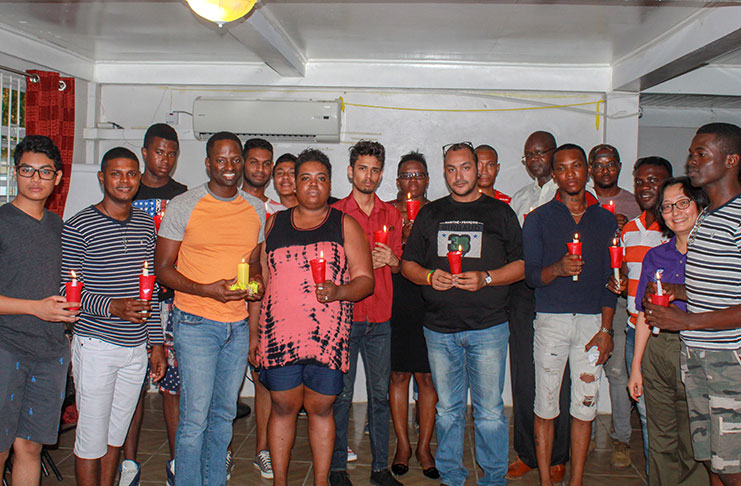
Guyana’s NAP Manager calls for greater societal involvement in tackling HIV.Dr Rhonda Moore assures that Government remains committed to funding treatment and testing through its National Health Strategy.
Image: Participants at SASOD’s Ninth Annual HIV and AIDS Candlelight Memorial
Even though the availability of treatment for HIV and AIDS has increased in Guyana over the years, Programme Manager of the National AIDS Programme (NAPS), Dr. Rhonda Moore has bemoaned that pervasive stigma and discrimination continue to hinder the fight.
Speaking at the ninth annual HIV and AIDS Candlelight Memorial organized by the Society Against Sexual Orientation Discrimination (SASOD) and held at the organization’s Lamaha Springs office, Dr. Moore stressed the need for greater societal involvement in tackling the disease.
According to her, Guyana has made strides in approving the accessibility of treatment for Human Immunodeficiency Virus infection and Acquired Immune Deficiency Syndrome (HIV/AIDS) and making this treatment affordable, even free of cost, yet persons are unable to access these services. “The elephant in the room continues to be stigma and discrimination,” the Programme Manager said.
Adding to her sentiments was Managing Director of SASOD, Joel Simpson, who spotlighted the fact that while persons are discriminated against for having HIV/AIDS, the Lesbian Gay Bisexual Transgender (LBGT) community continues to be further discriminated against and marginalized.
While the provision of medical services is critical, Dr. Moore also posited that cognizance of people’s rights regardless of their sexual orientation, ethnicity, creed or other attributes is tantamount.
Dr. Moore nevertheless noted that persons living with HIV, though discriminated against and are marginalized, are “the greatest teachers” in the efforts to reduce the scourge.
“Without the involvement of persons living with HIV, policymakers will never understand what needs to be done,” she noted.
And despite dwindling donor funding internationally to reduce the HIV/AIDS-related cases, Moore assured that the government remains committed to funding treatment and testing through its National Health Strategy.
The overarching international goals that Guyana has aligned itself with include the elimination of AIDS by 2030 and the achievement of the United Nations Programme on HIV and AIDS (UNAIDS) 90-90-90 target of diagnosing 90% of all HIV-positive persons; providing Anti-retroviral Therapy (ART) for 90% of those diagnosed; and achieving viral suppression for 90% of those treated by 2020.
“All Guyanese have a right to quality care,” Moore highlighted but stressed, “This can only be achieved through working together.”
On a macro-level, a Sustainability Oversight Steering Committee has been established by the Public Health Ministry to guide the sustainability plan for continuing the gains already made vis-a-vis the goals outlined. The Committee is chaired by Public Health Minister, Volda Lawrence and includes Junior Health Minister, Dr. Karen Cummings; Dr. Moore; representatives from civil society organizations; representatives from faith-based organizations; and representatives from government ministries, among others.
SASOD has been the local organizer for the annual AIDS Candlelight Memorial in Guyana since 2010. Also in attendance at the Memorial was UNAIDS Country Director, Dr. Martin Odiit; UN Resident Coordinator and UNDP Resident Representative for the Cooperative Republic of Guyana, Mikiko Tanaka; and members and supporters of SASOD.
WHAT IS PANCAP?
PANCAP is a Caribbean regional partnership of governments, regional civil society organisations, regional institutions and organisations, bilateral and multilateral agencies and contributing donor partners established on 14 February 2001. PANCAP provides a structured and unified approach to the Caribbean’s response to the HIV epidemic, and coordinates the response through the Caribbean Regional Strategic Framework on HIV and AIDS to maximise efficient use of resources and increase impact, mobilise resources and build the capacity of partners.
What are the Global AIDS Strategy 2021–2026 targets and commitments?
If targets and commitments in the strategy are achieved:
- The number of people who newly acquire HIV will decrease from 1.7 million in 2019 to less than 370 000 by 2025
- The number of people dying from AIDS-related illnesses will decrease from 690 000 in 2019 to less than 250 000 in 2025.
- The goal of eliminating new HIV infections among children will see the number of new HIV infections drop from 150,000 in 2019 to less than 22,000 in 2025.
What are the 95-95-95 Targets for ending AIDS?
- 95% of People Living with HIV know their HIV status;
- 95% of people who know their status on treatment; and
- 95% of people on treatment with suppressed viral loads.
HELPFUL LINKS:
Global AIDS Strategy 2021–2026, End Inequalities, End AIDS
https://pancap.org/pancap-documents/global-aids-strategy-2021-2026-end-inequalities-end-aids/
Caribbean Regional Strategic Framework on HIV and AIDS (CRSF) 2019-2025
https://pancap.org/pancap-documents/caribbean-regional-strategic-framework-2019-2025/
